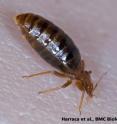Anti-aphrodisiac protects young bedbugs
Male bedbugs are known to be very unfussy when it comes to mating, mounting any well-fed bug they can see - regardless of age or gender. Researchers writing in the open access journal BMC Biology have discovered how immature bedbug nymphs, who would be harmed by the traumatic insemination technique practiced by the males, release alarm pheromones to deter this unwanted attention. Vincent Harraca, from Lund University, Sweden, worked with a team of researchers to stage encounters between males and females or nymphs. He said, "The chemical communication, as well as the mating behavior, of bed bugs has received increased attention in recent years as bed bug infestations have increased worldwide. Mating is exclusively traumatic, with the male piercing an opening in the female and ejaculating directly into the abdominal cavity. In order to avoid this, we've found that bedbug nymphs release aldehyde pheromones that let the male know that they should look elsewhere. These results may be applied to decrease bed bug populations by mating disruption".
Harraca and his colleagues prevented a group of nymphs from signaling by blocking their scent glands with nail polish. These 'silenced' nymphs were then found to experience the same percentage of mating with sperm transfer as a normal female. Furthermore, application of the pheromones, to a male/female pair during mounting initiation caused a decrease in mating frequency. The anti-aphrodisiac blend of aldehydes was shown to signal through olfactory receptor neurons in the antennae of the repelled males. This research provides new insights into the chemical communication system of bed bugs and challenges the common view that alarm pheromones are used as a predator defense mechanism only.
Speaking about the results, Harraca said, "The chemical communication system of the bed bugs is only just unfolding, and further analyses on longevity costs to nymphs as well as males who have been pierced is a high priority to fully understand the picture of traumatic insemination".
Source: BioMed Central
Other sources
- Battling the Bedbugs: At First You Shudderfrom Live ScienceTue, 14 Sep 2010, 16:42:21 UTC
- Anti-aphrodisiac protects young bedbugsfrom Science DailySun, 12 Sep 2010, 10:21:15 UTC
- Bedbug Anti-Sex Chemical May Treat Infestationsfrom Live ScienceFri, 10 Sep 2010, 17:07:12 UTC
- Anti-aphrodisiac protects young bedbugsfrom PhysorgThu, 9 Sep 2010, 9:14:17 UTC
